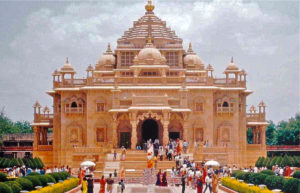A brief history of the Akshardham Temple at Delhi:
The Akshardham Temple complex (also known as AT complex) was constructed by the Bochasanwari Shri Akshar Purushottam Swaminarayan Sanstha (BAPS) in the year 2005. The BAPS is a subgroup of the Swaminarayan movement lead by Bhagwan Swaminarayan as a part of the Bhakti traditions. Swaminarayan, having born in a brahmin family in a small village near Ayodhya during the 18th Century, took to spiritual pilgrimage at a very young age. He spearheaded a socio-spiritual revolution and was even named ‘Neelkanth’. His travels had ended in Gujarat where he had succeeded Ramananda Swamy as the spiritual heir.

The BAPS has established several temples in many countries across the world and is said to have over a million followers from around the globe. Male celibates called the ‘swamys’ form the backbone of the organization. Only University graduates over the age of 21 are accepted into the organization. The Delhi AT complex is modeled based on another AT complex at Gandhinagar on a larger scale.
The Akshardham Temple Complex and its features:
Situated in the banks of river Yamuna, the construction of this temple had created a public controversy concerning the ecological sensitivity of the location. Eventually, the support for the ruling political parties and the Supreme Court’s decision of the Temple being legally constructed enabled the AT complex to be opened in November 2005. It is closely situated to Noida, an industrial development area that has now evolved as a part of Delhi suburb and jhuggi-jhopri slum, an area whose residents had been resettled for the purpose of beautification of the city.
High-security measures are taken in the AT complex such as usage of reflective security devices underneath vehicles, body frisking, inspection with metal detectors, etc. The temple provides the ambiance of a five-star hotel through its luxurious hallways and massive car parking areas.
The temple is open throughout the year except on Mondays, when maintenance work, as well as meetings for swamys, are held. Many technologically advanced features have been made an integral part of the temple structure. Architecturally also, the temple is considered astounding as it has incorporated many geometric forms as a representation of Indians’ knowledge of mathematics and geometry.
The planning of the complex has been that of an international level with many ideas for exhibitions. One such exhibit plan is the boat ride which is longer than the one in Universal Studios. It takes the riders on a swan-shaped boat (depicting the ancient Hindu theme) through a series of tableaus that describe the expertise of Indians in various fields such as astrology, democracy, medicine, etc. This ride ends with a scenario of modern India with a notion to cherish ancient heritage for a better future.
Then is the ‘Hall of Values’ where a large back-lit monolith made of granite sits. This hall consists of 15 walk-in 3-Dimensional dioramas animated by robotics and fiber-optics that presents the life of the founder as well as a village tableau which idealizes a village with the help of bridges, waterfalls, and rainfall depicting scenes. There is also an IMAX show which charts the life of Bhagwan Swaminarayan’s life from childhood to adulthood. The story is a travelogue that has later been re-titled ‘Mystic India’ and has been screened all over the world. The administration gives emphasis on crowd management and time management so as to maximize the volume of traffic.
Reference
Read the full text here, https://www.epw.in/journal/2009/26-27/special-articles/urban-spaces-disney-divinity-and-moral-middle-classes-delhi.html
We believe in sharing knowledge with everyone and making a positive change in society through our work and contributions. If you are interested in joining us, please check our ‘About’ page for more information
